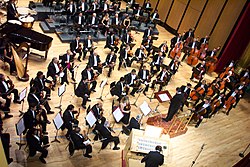This article has multiple issues. Please help improve it or discuss these issues on the talk page . (Learn how and when to remove these messages)
|



A musical ensemble, also known as a music group, musical group, or band, is a group of people who perform instrumental and/or vocal music, with the ensemble typically known by a distinct name. Some music ensembles consist solely of instrumentalists, such as the jazz quartet or the orchestra. Other music ensembles consist solely of singers, such as choirs and doo-wop groups. In both popular music and classical music, there are ensembles in which both instrumentalists and singers perform, such as the rock band or the Baroque chamber group for basso continuo (harpsichord and cello) and one or more singers. In classical music, trios or quartets either blend the sounds of musical instrument families (such as piano, strings, and wind instruments) or group instruments from the same instrument family, such as string ensembles (e.g., string quartet) or wind ensembles (e.g., wind quintet). Some ensembles blend the sounds of a variety of instrument families, such as the orchestra, which uses a string section, brass instruments, woodwinds, and percussion instruments, or the concert band, which uses brass, woodwinds, and percussion. In jazz ensembles or combos, the instruments typically include wind instruments (one or more saxophones, trumpets, etc.), one or two chordal "comping" instruments (electric guitar, acoustic guitar, piano, or Hammond organ), a bass instrument (bass guitar or double bass), and a drummer or percussionist. Jazz ensembles may be solely instrumental, or they may consist of a group of instruments accompanying one or more singers. In rock and pop ensembles, usually called rock bands or pop bands, there are usually guitars and keyboards (piano, electric piano, Hammond organ, synthesizer, etc.), one or more singers, and a rhythm section made up of a bass guitar and drum kit.
Contents
- Classical chamber music
- Four parts
- Five parts
- Six or more instruments
- Vocal group
- Based on genders
- Based on project type
- Others
- Other western musical ensembles
- Role of women
- See also
- References
- External links
Music ensembles typically have a leader. In jazz bands, rock and pop groups, and similar ensembles, this is the band leader. In classical music, orchestras, concert bands, and choirs are led by a conductor. In orchestra, the concertmaster (principal first violin player) is the instrumentalist leader of the orchestra. In orchestras, the individual sections also have leaders, typically called the "principal" of the section (e.g., the leader of the viola section is called the "principal viola"). Conductors are also used in jazz big bands and in some very large rock or pop ensembles (e.g., a rock concert that includes a string section, a horn section, and a choir that accompanies a rock band's performance).




